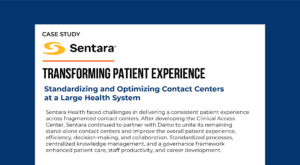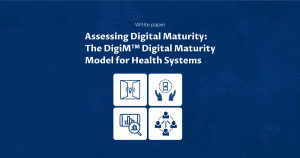The Cambrian explosion driving digital health and digital transformation
The Cambrian explosion refers to an intense burst of growth in life forms on earth during a relatively short time in the Cambrian period, over 500 million years ago. Today, we are witnessing a similar explosion in digital health solutions.

Originally published on MedCity News
The digitalization of the patient journey has accelerated significantly in the past 18 months. There is now an expanded range of digital engagement touchpoints and a significant increase in the number of solution providers who claim to have a unique ability to address the opportunities. Terms like “digital front door” and “patient engagement solution” have become catch-all phrases to define the offerings for any number of startups and early-stage companies. We now have a vast ecosystem of similar-sounding startups, often with overlapping capabilities.
Digital health funding has gone up dramatically – roughly doubling every year in the last few years – and is set to exceed $20 billion in 2021 by most estimates. Notwithstanding the breathless excitement that the funding numbers generate, we may be in the very initial stages of the funding cycles for digital health over the coming decade, given that healthcare is a $4 trillion economy that has been relatively slow to embrace digital transformation.
Digital maturity varies widely across healthcare
Many of the larger health systems across the nation have made significant progress in their digital transformation journeys. A question that often comes up is: what is the digital maturity of healthcare organizations. The answer often depends on the organizational model for driving digital transformation. We see that the more mature organizations have both the board and executive leadership commitment to digital transformation supported by a multi-year transformation budget; there is typically a small group of senior executives (including a dedicated Chief Digital Officer) driving strategic intent and working in close co-ordination to ensure tight handoffs from one phase of transformation to the next; they partner with best-in-class technology providers, often forming strategic alliances with a handful of enterprise-class technology vendors while tapping into innovative startups. The leading health systems across the nation are leveraging a range of technology tools to set new standards for digital patient engagement, drawing from the playbook of other, more advanced sectors while recognizing the unique needs of health care consumers.
However, a number of health systems across the nation are also struggling to stay ahead of multiple market forces impacting their growth, profitability, and long-term competitiveness. Health systems in regions with flat or declining population growth may need to invest in increasing patient engagement with a range of tools, including EHR, CRM, and telehealth, to tap into growth opportunities from new patient acquisition and referrals, care gap management, and even improved recovery of overdue payments. Often, health systems are challenged in gaining acceptance and adoption within its clinical and caregiver community to embrace digital solutions. The solution for improved digital patient engagement may lie with senior leadership commitment and funding challenges and organizational maturity in deploying digital health technologies. The steady encroachment of digital-first healthcare providers into traditional markets is often based on designing and delivering superior experiences with the same technologies.
Parsing the rapidly growing landscape of digital health solutions
The Cambrian Explosion refers to an intense burst of growth in life forms on earth during a relatively short time in the Cambrian period, over 500 million years ago. Today, we are witnessing a similar explosion in digital health solutions in what may be a defining moment in the digital transformation of healthcare. There is no shortage of innovative ideas in developing solutions to aid the digital transformation of healthcare and no lack of interest from healthcare organizations for the same. However, the vast landscape of emerging digital health solutions has left healthcare executives confused and fearful about making the wrong technology solution choices.
Here are a few approaches and considerations for health systems to make effective technology and partner choices for implementing a multi-year digital transformation roadmap.
-
- Go with “EHR-first,” but don’t be limited by “EHR-only”: The major players in the electronic health record (EHR) system space have built significant digital capabilities, especially for core aspects of healthcare operations related to access to care. EHR platforms also provide the convenience of seamless integration into the workflow of care delivery and care management, which is often the most compelling argument advanced by the EHR vendors in convincing healthcare executives to go with an “EHR-first” strategy for digital transformation. Not to mention that for health systems with a low appetite for financial and technology risk, an EHR-focused approach makes the most sense. However, an “EHR-first” approach can be limiting in the fast-changing environment of consumer expectations. Health systems that have made the most progress with digital health programs have integrated a number of best-in-class stand-alone solutions to augment or replace native EHR capabilities; examples include self-service capabilities for provider directory lookups, online payment gateways, and chatbots.
-
- Look to mature tech firms with robust enterprise-class platforms: Big tech firms are making big bets in healthcare. The largest ones are pursuing a multi-pronged approach to healthcare that includes acquiring large, established technology firms (e.g., Microsoft’s acquisition of Nuance), focusing on a primary differentiating capability (e.g., Salesforce for CRM). In some cases, tech firms appear to compete directly with health systems (e.g., Amazon in primary care). Despite the confusing market strategies, each of the big tech firms offers core capabilities that can drive health systems forward in their transformation efforts. As the landscape evolves, healthcare executives will also find themselves in conversations with tech firms competing on unfamiliar turf. An example of this is one of the leading EHR vendors positioning itself lately as a CRM platform provider. An important consideration is that most enterprise-class technology firms sell platforms, not point solutions. There is an additional effort for the customization, integration, and ongoing support work, leading to a much higher total cost of ownership for health systems. As a general rule, enterprise-class platforms deliver value at scale, implying a need to aim for enterprise-wide deployment that may involve consolidating smaller, stand-alone solutions into fewer platforms.
-
- Embrace digital health innovators and startups but hedge your risks: The excitement around digital health innovation is tempered somewhat today by the risks involved. Many innovative startups have carved a niche for themselves through carefully managed product development and market growth with the backing of venture capital. The reality, however, is often that these companies are operating at a sub-scale, sustaining themselves on a handful of clients. Many of these firms often merge with other startups or get acquired by larger firms to achieve scale and remain relevant. Well-funded startups can also disappear practically overnight with no warning. Healthcare executives may find themselves spending a lot of time and internal resources to help build a vendor’s product, only to find the company snapped up by a larger firm, lose its key personnel to other clients, and a host of other unexpected outcomes. A hedging strategy adopted by some health systems is to take equity positions selectively in startups. Besides providing a degree of control over the future direction of the startup, it can offer upsides in the event of a profitable exit event.
There are no easy answers to the questions on technology strategy in the rapidly evolving landscape of digital health solutions. There is a crowded landscape of technology firms offering solutions for every digital engagement touch point in a consumer journey. Healthcare executives often don’t know where to begin in evaluating their solution options. Healthcare executives must often learn to look past the inflated claims about products in a relatively immature sector. For health systems that can make the right choices, the bets can pay off handsomely. For those that do not, there could be a painful process of unwinding and switching that can have consequences for patient experience and outcomes, not to mention opportunity costs and disruption to growth, especially in competitive markets. It would be helpful to remember that the multi-cellular organisms that emerged from the Cambrian explosion didn’t all survive. The ones that did, though, dominated the planet for a few hundred million years – till another big event took most of them out. We’re nowhere close to that moment yet, metaphorically speaking.














